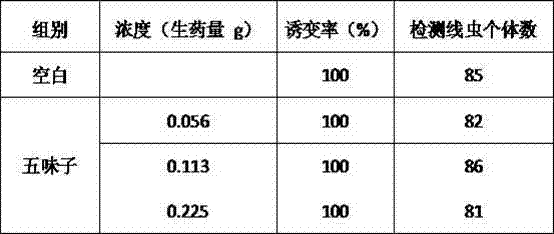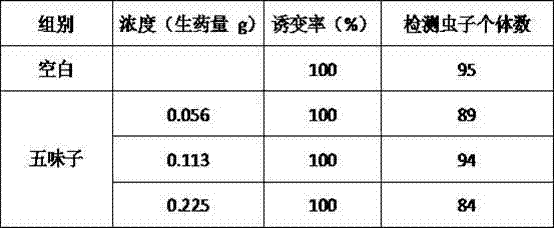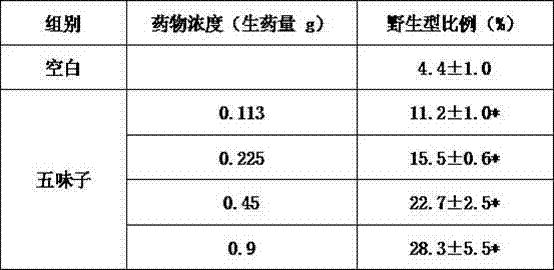Application of schisandra chinensis in inhibition of ras proto-oncogene overexpression
A proto-oncogene, Schisandra chinensis technology, which is applied to plant raw materials, medical preparations containing active ingredients, plant/algae/fungus/moss components, etc., can solve the problem of no literature report on Schisandra chinensis, etc., and achieves widening the scope of medication and better treatment. Effect
- Summary
- Abstract
- Description
- Claims
- Application Information
AI Technical Summary
Problems solved by technology
Method used
Image
Examples
Embodiment 6
[0011] The preparation of embodiment one schisandra medicinal liquid
[0012] Schisandra source: purchased from Lanzhou Yellow River Medicine Market.
[0013] Weigh 9 g of Schisandra chinensis; first soak in distilled water for 20 minutes, then boil at a slow fire, decoct for 30 minutes, constant volume, centrifuge, discard the precipitate, filter the supernatant aseptically, put it in a 4°C refrigerator for later use, and dilute to different concentrations when used.
[0014] Example 1 The effect of Schisandra medicinal liquid on Caenorhabditis elegans MT2124 (let-60 hyperactivation mutation)
[0015] Ras is a small molecular protein that participates in the regulation of many important links in animal development. The ras signaling pathway is highly conserved from nematodes to humans. The let-60 gene encodes a conserved Ras protein in Caenorhabditis elegans, which has 83% homology with human Ras proteins. If the ras mutation, in Caenorhabditis elegans, it will cause th...
Embodiment 8
[0034] Example 3 The effect of Schisandra chinensis on Caenorhabditis elegans MT8189 (lin-15 mutation inactivation)
[0035] Experimental materials: Caenorhabditis elegans MT8189, polyvulva phenotype, genotype: lin-15b(n765)X, purchased from CGC (Caenorhabditis Genetics Center); Escherichia coli OP50 (uracil leaky mutant strain), used as Caenorhabditis elegans Nematode food was purchased from CGC (Caenorhabditis Genetics Center).
[0036] Concrete experimental procedure: with embodiment two.
[0037] Table 2 Effect of Schisandra chinensis on Caenorhabditis elegans MT8189 (lin-15 mutation inactivation)
[0038]
[0039] In Caenorhabditis elegans, lin-15(n765)X is located upstream of ras and normally inhibits the expression of ras gene. The inactivation of this gene in the MT8189 nematode strain leads to the phenotype of multiple ovipositors in the nematode.
[0040] As shown in the table, Schisandra can not inhibit the polyvulva phenotype of lin-15(n765)X. According to...
Embodiment 9
[0041] Example 4 Effect of Schisandra chinensis on Caenorhabditis elegans CB1275 (lin-1 mutation inactivation)
[0042] Experimental materials: Caenorhabditis elegans genotype: lin-1(e1275) IV was obtained from CGC (Caenorhabditis Genetics Center); Escherichia coli OP50 (uridine leaking mutant strain), as the food of Caenorhabditis elegans, was purchased from CGC.
[0043] Concrete experimental procedure: with embodiment two.
[0044] Table 3 The effect of Schisandra chinensis on Caenorhabditis elegans CB1275 (lin-1 mutation inactivation)
[0045]
[0046] lin-1 is a gene downstream of ras, a nuclear transcription factor that can be phosphorylated by MAPK, a negative regulator of vulva development, and a signaling pathway that regulates vulva development downstream of let-60. After lin-1 mutation inactivation, nematodes have polyvaginal phenotype. Since lin-1 is a nuclear transcription factor, it regulates the process of vulva cell development. If the drug has a signif...
PUM
 Login to View More
Login to View More Abstract
Description
Claims
Application Information
 Login to View More
Login to View More - R&D
- Intellectual Property
- Life Sciences
- Materials
- Tech Scout
- Unparalleled Data Quality
- Higher Quality Content
- 60% Fewer Hallucinations
Browse by: Latest US Patents, China's latest patents, Technical Efficacy Thesaurus, Application Domain, Technology Topic, Popular Technical Reports.
© 2025 PatSnap. All rights reserved.Legal|Privacy policy|Modern Slavery Act Transparency Statement|Sitemap|About US| Contact US: help@patsnap.com



